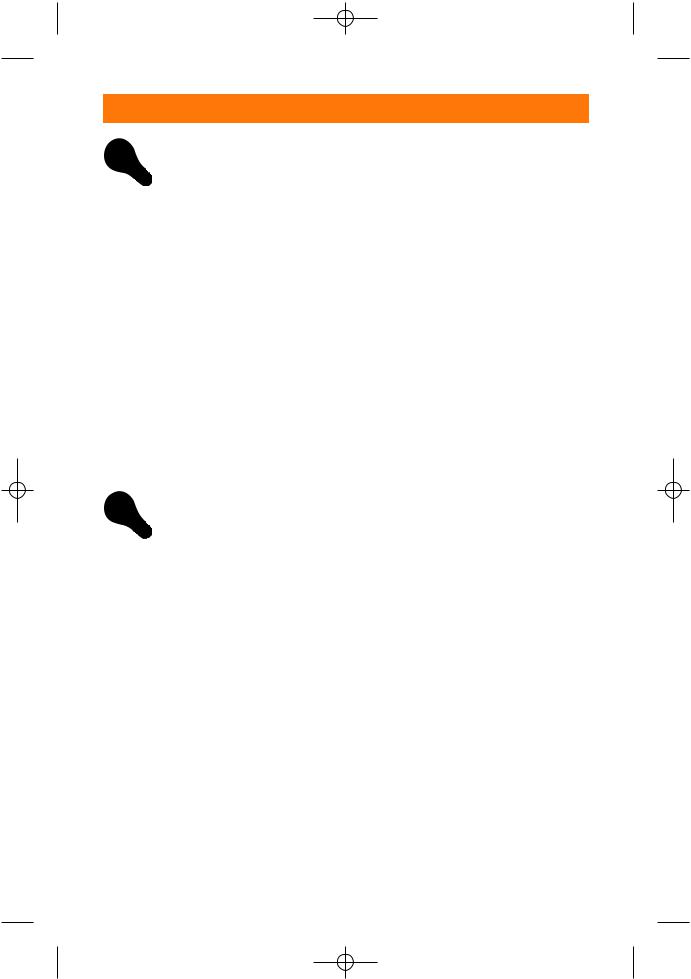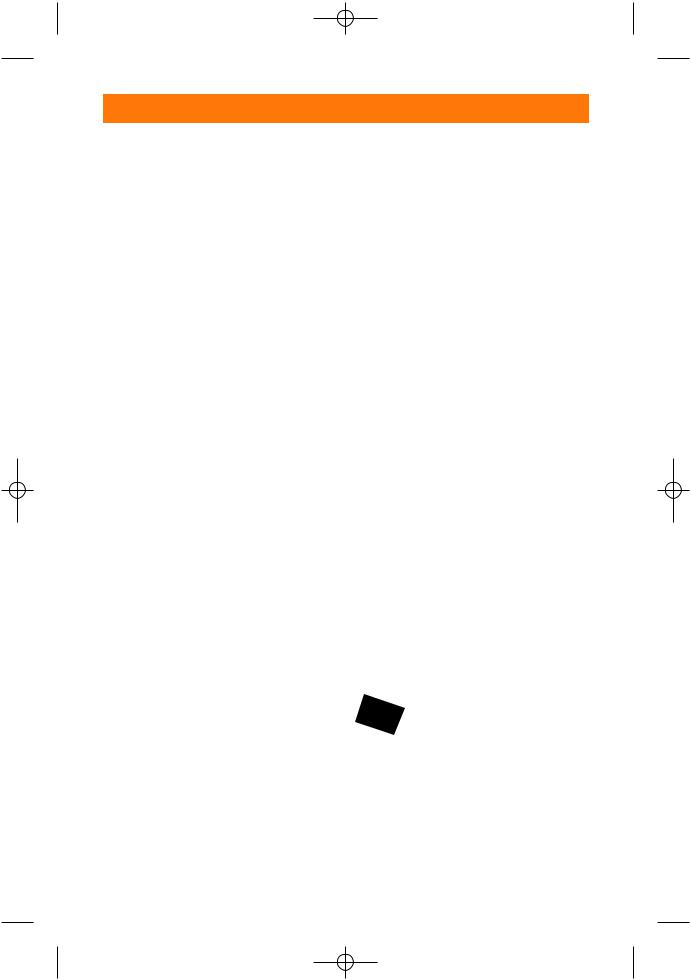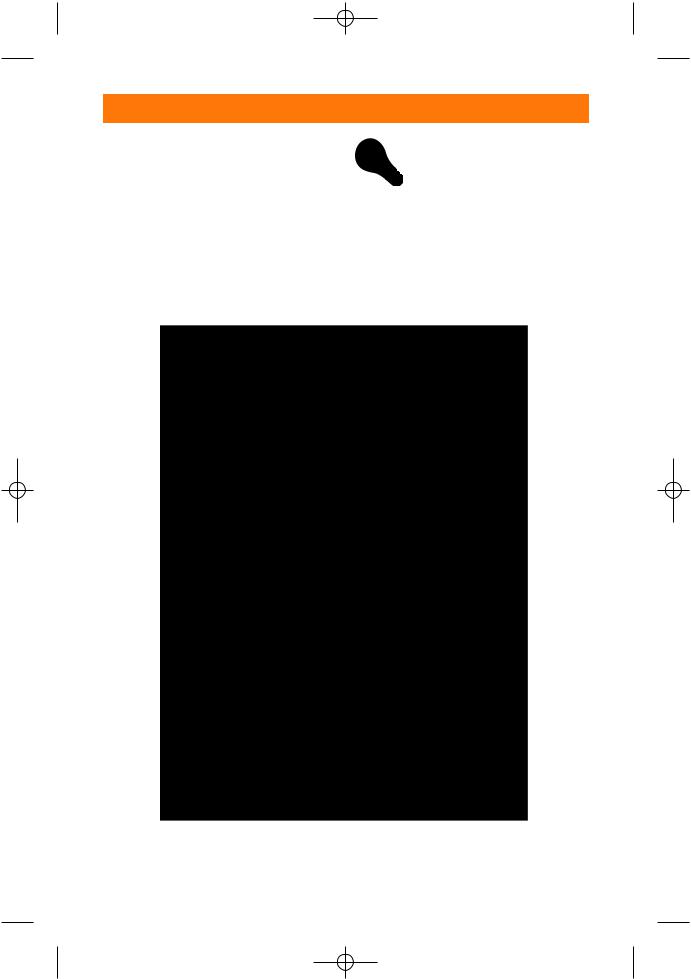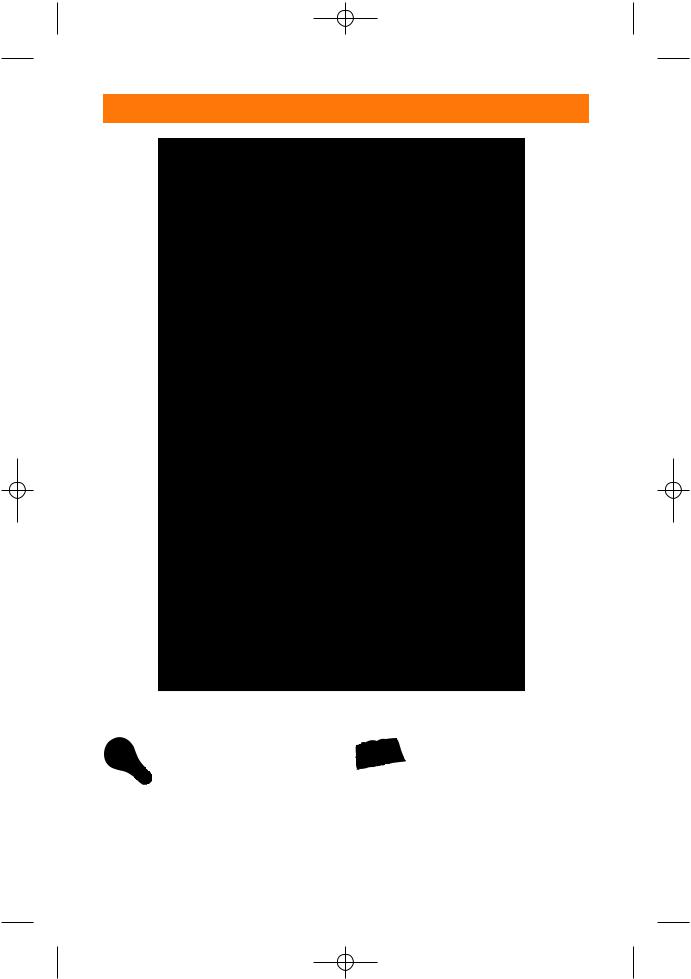
0470045272
.pdf
12_045275 ch06.qxp 11/28/06 8:26 PM Page 161
|
|
Chapter 6 Real World Applications 161 |
|
|
|
|
|
|
|
|
|
|
|
Table 6.12 |
|
|
|
Taking Studio Portrait Pictures |
|
|
|
|
|
|
Setup |
Practice Picture: I set up my portable studio at the back of |
|
|
|
Salon Square in Las Vegas, NV to shoot some photographs. |
|
|
|
Figure 6.37 is just one of many I took that day. |
|
|
|
On Your Own: As long as you have a good background (and |
|
|
|
your equipment) you can do studio portraits anywhere. |
|
|
|
|
|
|
Lighting |
Practice Picture: I mounted one SB-600 on a boom stand at a |
|
|
|
60 degree angle to the model’s face. The Speedlight was then |
|
|
|
bounced from an umbrella. The second SB-600 was pointed at |
|
|
|
the backdrop. The SB-600’s were controlled by the D70’s built-in |
|
|
|
Speedlight. Both SB-600’s were set to TTL with the exposure |
|
|
|
compensation set to +2, to compensate for the light lost when |
|
|
|
bouncing from the umbrella. |
|
|
|
On Your Own: Use one or more Speedlights to create the |
|
|
|
desired lighting pattern and mood. |
|
|
Lens |
Practice Picture: Nikkor 80-200mm f/2.8 |
|
|
|
On Your Own: Use a medium to long telephoto lens to enhance |
|
|
|
the model’s features. |
|
|
|
|
|
|
Camera Settings |
Practice Picture: Manual mode |
|
|
|
On Your Own: Use Manual or Aperture Priority mode to control |
|
|
|
the depth of field. |
|
|
Exposure |
Practice Picture: 1/500 sec. at f/5.6, ISO 200 |
|
|
|
On Your Own: Set your shutter speed at or near your camera’s |
|
|
|
sync speed. Using a wide aperture is not absolutely necessary |
|
|
|
when using a plain background, but it helps to let more light in |
|
|
|
so your Speedlight can fire at a lower power, giving you longer |
|
|
|
battery life. |
|
|
|
|
|
|
Accessories |
A fold up reflector is a great idea. As you can see in figure 6.37, |
|
|
|
you can get professional-looking portraits using only one |
|
|
|
Speedlight on the model, but you need a reflector to bounce |
|
|
|
some light into the dark side of the face. |
|
|
|
|
|

12_045275 ch06.qxp 11/28/06 8:26 PM Page 162
162 Part II Creating Great Photos with the Creative Lighting System
Studio portrait photography tips
Use a long lens. Long lenses flatten your subject’s features by reducing the apparent distance, which is the distance objects look from each other from a certain perspective. For example, if you use a wide-angle lens at close range it can cause the nose to look big while also causing the ears to look too small.
Use different color backgrounds.
Using colors that compliment your subject’s features and clothing can make a portrait stand out.
Focus on the eyes. The most important part of a portrait is the eyes. Make sure that they are in focus. If the eyes are a little fuzzy the whole portrait looks off.
Have a list of poses ready.
Subjects often feel uncomfortable posing unless they are professional models. By having poses in mind ahead of time, it minimizes setup changes and the shoot goes smoother.
Be ready. Once your subject is relaxed and feels comfortable, the shooting becomes easier and poses become more natural.

13_045275 ch07.qxp 11/28/06 8:29 PM Page 163
Simple
Posing for
Great
Portraits
One of the most important aspects of portrait photography is knowing how to pose your subjects. If your model looks awkward or uncomfortable, your portrait isn’t
going to be a success. The key to a good portrait is having the model look natural.
To be a successful portrait photographer, you need to have good technical skills, but posing subjects is an art form unto itself. As soon as you start to master the art of posing subjects, you’ll find that the quality of your work will grow by leaps and bounds.
Ultimately, you need to create a set of standards that you use that works best for the types of portraits you and your clients like to see. Once you develop your own style, by sticking to your best practices, you will see great improvement in your portrait portfolio.
Posing Basics
Photographic posing isn’t new; actually, posing has evolved over the centuries. Some of the best portraits I’ve ever seen weren’t even photographs, but painted portraits dating back hundreds of years. In touring art museums here and abroad, I’m still amazed at the detail and subject matter of paintings
C 7H A P T E R
In This Chapter
Individual posing techniques
Planning your posing
Posing basics
Positioning parts of the body

13_045275 ch07.qxp 11/28/06 8:29 PM Page 164
164 Part II Creating Great Photos with the Creative Lighting System
created by masters of long ago. To be fair, portrait photography has taken the art form further, some say by leaps and bounds. A little combination of both styles goes a long way.
Whether it is classic or cutting edge portraiture, some rules remain the same. Your subjects still need to seem natural and without any distortions to the person’s features. You can follow a number of basic rules but don’t have to adhere to them for every portrait. These rules are a great starting point for every digital portrait photographer.
Basic poses for individuals include:
Shoulders at an angle. This is one of the first rules in portraiture. The subject’s shoulders should be turned at an angle to your camera. Use this rule often, for both standing and seated situations. When the shoulders are evenly facing the photographer, the subject looks unnaturally wider. Figure 7.1 shows a simple portrait taken with the shoulders pointed at an angle to the camera. Try to ensure that the shoulder closer to the camera is lower than the other shoulder.
Head tilted. After subjects turn their shoulders so they’re on an angle, ask them to tilt and turn their head slightly so the head isn’t in the same position as the shoulders. When you have your subjects tilt and turn their head slightly, you’re also changing the position of the eyes, giving a more naturally interesting look to the portrait with a dynamic touch.
7.1 Pose your subjects with their shoulders pointed at an angle to the camera.
7.2 A slight tilt of the head adds drama to a portrait.

13_045275 ch07.qxp 11/28/06 8:29 PM Page 165
Chapter 7 Simple Posing for Great Portraits 165
Tip |
When making changes to a per- |
|
son’s posture, try not to make |
|
the changes dramatic. Usually, |
|
just a slight turn and tilt of the |
|
head does the trick. You don’t |
|
want to have the pose appear |
|
overdone. |
Feet placed naturally. If you’re shooting full length portraits, whether the subject is standing or sitting, make sure you pay close attention to feet. You want the feet positioned close enough together, but not un-naturally. Additionally, if your subject is facing you on an angle, place the foot closest to you angled slightly more toward the camera than the other foot. This adds more balance to the subject in some portraits, and naturally turns the subject’s body more toward the camera.
Tip |
Try posing your subject’s feet |
|
first, and then work your way |
|
up. |
After you understand some of these basic posing techniques and try them out on occasion, you’re ready for the next step, which are more elaborate portrait posing techniques. I’m not talking about posing every single inch of a subject’s body; just some subtle changes to posture or position can go a long way in making a great portrait.
Refined Posing
Techniques
As a photographer, I consider posing an art form in itself. After I determine what type of portrait I’m photographing, I then go to work on setting up the entire body for the
pose I want. I start with the feet and legs and then work my way up. Even though a small percentage of portraits are actually full-body length shots, a best-practice is to pose the subject as if their entire body is going to be included in the portrait. While you are shooting, make sure to take a few full-length shots as you may discover a few hidden gems among your images that way.
Positioning the midsection
In the real world, not all of your subjects are going to be twenty-ish models that weigh 100 pounds. Mastering techniques where you can photographically slim the midsection of your subjects is important. This is increasingly important when photographing clients who are conscious of their weight.
Establish upfront with your subject whether they want full length poses or just to be photographed from the waist up. To make subjects appear thinner, never have them pose square to the camera. For standing positions, have your subjects turn their hips toward the left or right, preferably away from the main light. You can also consider having your subjects shift their weight to the hip closest to the camera.
Other slimming techniques include:
Legs separated slightly. In addition to having your subject turn his or her hips slightly to the left or right, you should also suggest a stance with the legs slightly separated. Avoid full-length portraits where both legs are positioned close together; keep a separation at the thighs when possible.
Legs crossed. I use this pose quite often. Have your subject turn at an angle, either left or right (preferably toward the main light), and

13_045275 ch07.qxp 11/28/06 8:29 PM Page 166
166 Part II Creating Great Photos with the Creative Lighting System
shift his or her weight to the leg closest to the camera with one leg crossing the other. This creates a slight lean that looks very natural in most cases.
Clothing can also contribute to or hinder your efforts to illustrate a thinner appearance to your subject. Baggy clothing doesn’t help. Be creative in those situations where your subject is wearing a pair of baggy pants, a baggy shirt, or a loose fitting dress. Have subjects lean a leg on a chair or lean on an object to thin out their appearance in the portrait when wearing baggy clothing.
Positioning the arms and hands
Working your way up, you can use a number of tips and techniques to properly position your subject’s arms and hands. Using the body to make up the main composition, positioning of the arms and hands add to the desired look or style of the photograph. You want to make the person look his or her best.
Tried and true positions for the shoulders, arms, and hands include:
Triangle pose. If you’re not shooting a full-length portrait, a common technique to properly frame the portrait is the triangular pose. Try filling the bottom of the frame with your subject’s arms folded, filling in the bottom of the triangle, where the arms and shoulders lead up to the triangle’s peak, the person’s head.
Shoulders diagonal. Shoulders are going to be a major anchoring point for almost all of your poses. As a rule of thumb, your subject’s shoulders should never be positioned
horizontally across the frame. Have clients position their shoulders on a diagonal position to add interest to the portrait.
One arm away from the body. To complete the body portion of your portrait, have the subject positioned with at least one arm away from his or her body to help define the midsection. Within this parameter, arms can be positioned in many ways. For waist-up portraits, having the arms leaning on a chair or other object gives a relaxed appearance to the portrait. Try having subjects shift their weight to their elbows and relax their forearms.
Hands relaxed. Hands are often the most overlooked part of the body in portraits; however, paying attention to the detail when it comes to posing a subject adds to the quality of what you’re trying to achieve. Hands are important, and you want to ensure that the subject isn’t wearing any unusual bracelets or rings that can detract from your portrait. Be tactful, and ask the subject if they can remove any distracting jewelry or accessory that may not work for the portrait. Additionally, make sure the subject’s fingers are straightened and relaxed. You don’t want fingers curled under in a portrait.
Note |
There are exceptions to every |
|
rule. Always gauge what you |
|
ask of your subjects by their per- |
|
sonalities and what you know |
|
about them. That pinky ring |
|
may be a family heirloom or |
|
that brooch a special gift. So, |
|
use your best judgment when |
|
setting up your portraits. |

13_045275 ch07.qxp 11/28/06 8:29 PM Page 167
Chapter 7 Simple Posing for Great Portraits 167
Positioning the head and neck.
The final step is positioning of the head. Simple adjustments, such as having the head tilted slightly or resting on an object, can add an artistic effect to any portrait. There are actually a few decisions to make
when positioning the head, the first being what type of pose do you and your subject want for the portrait.
For me, the eyes are the most important part of any portrait. Eye contact is a focal
7.3 Sometimes looking away from the camera can create a powerful portrait.

13_045275 ch07.qxp 11/28/06 8:29 PM Page 168
168 Part II Creating Great Photos with the Creative Lighting System
point where you need to ask your subjects
to focus their gaze toward the camera. For |
Tip |
When shooting portraits either |
|
indoors or outdoors, consider |
|||
some portraits, you want subjects to direct |
|
||
|
adding fill flash to create a |
||
their eyes in another direction. |
|
||
|
catchlight in your subject’s eyes. |
||
|
|
The eyes are an important com- |
|
When taking portraits, I often have subjects |
|
ponent in your overall posing, |
|
try to focus their eyes in a few directions by |
|
and attention to detail, such as |
|
|
including catchlight, adds to the |
||
first looking directly toward my lens, and |
|
||
|
quality of your portraits. |
||
then asking them look to the left, right, |
|
||
|
|
||
slightly up, or slightly down. |
|
|
7.4 Looking up and slightly left

13_045275 ch07.qxp 11/28/06 8:29 PM Page 169
Chapter 7 Simple Posing for Great Portraits 169
In addition to paying close attention to the eyes, other areas of the head are important as well. You already know about tilting the head, but you also need to consider hair posing your subjects.
For individuals with long hair, make sure you have enough room in your frame to showcase that part of the person.
7.5 Looking up and turning slightly right

13_045275 ch07.qxp 11/28/06 8:29 PM Page 170
170 Part II Creating Great Photos with the Creative Lighting System
7.6 Pay close attention to hair and positioning the head to where the hair is a complimentary part of the composition.
Tip |
Necks often reflect weight or |
|
age of a subject. To achieve a |
|
pleasing portrait, consider either |
|
hiding portions of the neck with |
|
clothing or positioning the por- |
|
trait to reduce the amount of the |
|
person’s neck included. A good |
|
technique to use to reduce dou- |
|
ble chins is to have your subject |
|
slightly tip his or her head |
|
upward. |
For group portrait posing tips see the section on group portraits in Chapter 6.
